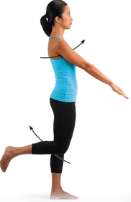Muscles
Muscles
Knowledge
Muscle Cells
Muscles
This muscles are responsible for adducting the thighs, often become un-toned quickly.
What are the adductor muscles?
This type of exercise is optimal for generating stronger muscles
What is resistance or isometric training?
This is the main source of energy for movement of our muscles.
What is ATP?
This type of movement is around its longitudinal axis, as seen in our atlas and axis joint.
What is rotation?
What is the gluteus maximus?
This muscle is found in the neck and allows for its rotation.
What is the sternocleidomastoid?
This type of muscle is categorized by being striated and voluntary.
What is skeletal muscle?
This reaction occurs when muscles contract, it removes a phosphate from ATP and generates energy.
What is hydrolysis or ATP hydrolysis?
This is the opposite of adduction, and moves our limbs away from our midline.
What is abduction?
This group of muscles makes the anterior of our thigh, containing four major muscles including the three vastus muscles.
What are the quadriceps group?
This is the muscle that covers the shoulder joint. It is named after the Greek letter, Δ.
What is the deltoid?
This is the 'place' where a muscle starts its attachment.
What is the origin?
This is the normal way that we obtain energy, yielding the highest amount of ATP at 32 per glucose molecules.
What is aerobic respiration?
This type of movement means that a body part is being turned inward.
What is inversion?
This muscle makes up the posterior of our upper arm and is responsible for elbow extension.
This is the muscle of the upper back, it helps with movement of the scapula.
These are the two types of muscle filaments that make up a sarcomere, the functional unit of the muscle cell.
What is actin and myosin?
This type of energy-making pathway does not require oxygen but has a low yield of 2 ATP.
What is anaerobic pathway?
This type of movement allowing bones to move closer together.

What is flexion?
This muscle is deep to the biceps brachii and helps in with elbow flexion.
What is the brachialis?
What are external obliques?
This is the neurotransmitter responsible for muscle contractions, it gets released when there is enough Ca ions in the axon terminal.
What is acetlycholine or ACh?
This natural molecule in our bodies that is only found in muscle cells. This is responsible for direct phosphorylation of ADP to ATP.
What is creatine phosphate or CP?
This type of movement means "turning backward" when your forearm is rotated laterally.
This group of muscles makes up the posterior of our thigh and includes muscles like the bicep femoris.
What is the hamstring group?
This is the "upper" muscle of the buttock region that is important for IM injections.
What is the gluteus medius?
This homeostatic imbalance of the muscular system is when neurons break down over time and motor function begins to decline.
What is ALS or Lou Gehrig's Disease?
This type of energy-making pathway is responsible for making energy that will last hours.
What is the aerobic pathway?
This is the movement of the foot by pointing them away from your body.
What is plantar flexion?
This muscle runs across you shin to aid in dorsiflexion and foot inversion.
What is the tibialis anterior?